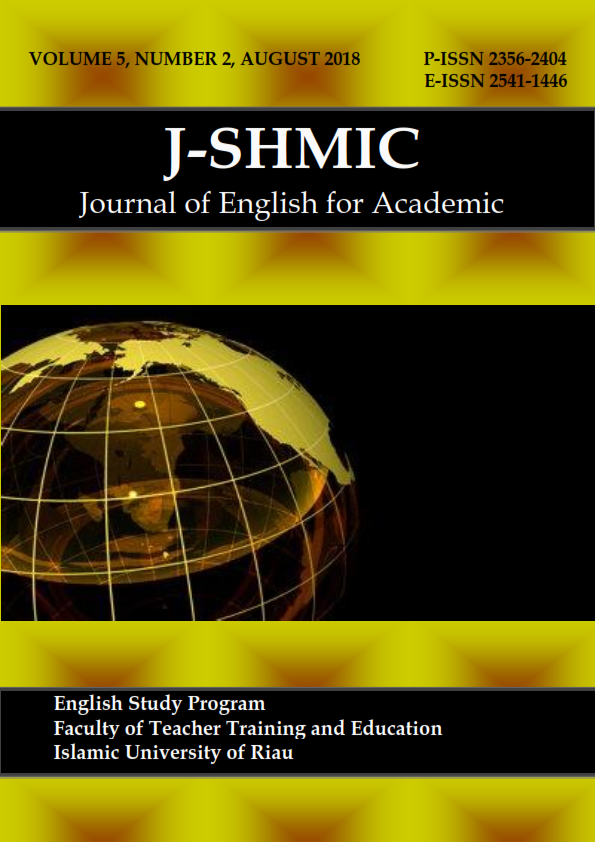Applying Impromptu Speech Technique to Improve Students’ Speaking Ability at the Fourth Semester Students of STIBA Persada
Keywords:
Impromptu speech technique, Speaking abilityAbstract
Based on the writer’s preliminary study, it was found that the speaking ability of the students were still low. Some of students were not able to pronounce well, were not able to express their ideas, and were afraid of making mistakes when they were speaking. All of those problems were caused by several factors, one of them was the way of teaching was not appropriate for the students. In this research, the writer applied Impromptu Speech technique which has been proven can improve students’ speaking ability, it is one teaching technique that is very useful for teaching speaking. This technique enables students to develop their capability to think on their feet, organize ideas quickly, and speak informatively and confidently about variety of topics. The subject of this research was the fourth semester students of Sekolah Tinggi Ilmu Bahasa Asing (STIBA) PersadaBunda, and the object was the effect of applying Impromptu Speech technique. The writer used simple sampling to take the sample. The writer used Non Equivalent control group design that used one group as the experimental class and one group as control class. The writer used Independent Sample t-test to analyze the data. Based on the data analysis, Consideration Sig (2tailed) t0= 0.000 is lower than Sig (2 tailed) ttable= 0.005, it means Ha was accepted and H0 is rejected. So, it can be concluded that there is a significant effect of applying Impromptu Speech technique to improve students’ speaking ability at the fourth semester students of STIBA Persada Bunda Pekanbaru.
Downloads
References
Alderson, J. carles. 2004. Assessing Speaking. New York: Cambridge University press
Betty Schrampfer. 1989. Understanding and Using English Grammar. New Jersey: Prentice Hall Regents, 1989.
Ag. Bambang Setiyadi. 2006. Metode Penelitian Pengajaran Bahasa Asing; Pendekatan Kuantitatif dan Kualitatif. Yogyakarta: Graha Ilmu.
Brown, H. Douglas. 2004. Language Assessment: principle and Classroom Practices. New York: San Francisco State University
Brown, James Dean. 1995. The Elements of Language Curriculum. Boston: Heinle and Heinle Publisher
B-Ikeguchi, Cecilia. 2010. Training for Impromptu Speaking and Testing Active Listening. http://iteslj.org/Techniques/Ikeguchi-Speaking.html.
Bratt Paulston, Christina. 1976. Teaching English as a Second Language: Techniques and Procedures. Cambridge: Winthrop Publisher.
Carstairs, Andrew. 2002. An Introduction to English Morphology: Words and their structures. Edinburgh: Edinburgh University Press
Croswell, John M. 2008. Educational Research: Planning, Conducting, and Evaluating, Quantitative and Qualitative Research. New Jersey: Merrill Prentice Hall
Cyril, J. Weir. 1990. Communicative Language Testing. New York: Prentical Hall,
C. Richard, Jack and S. Rodgers, Theodore. 1979. Approach and methods in language teaching: a Description and Analysis. New York: Cambridge University Press Cambridge
E. Williams, David at all. Is It Time for a Change in Impromptu Speaking. 1992. Retrieved on December 3rd 2011 cas.bethel.edu/dept/comm/nfa/journal/vol11no1-3.pdf.
Fillmer, H.Thompson. 1977. Patterns of Language. New York: Litton Educational publishing, Inc..
Flanders, Cathrine. 1979. The Challenge of Effective Speaking. United States America: Wadsworth Publishing Company,Inc
Gay, L.R and Peter Airasian. 2000. Educational Research Competencies for Analysis and Application. New Jersey: Prentice-Hall, Inc.,
Hughes, Arthur. 2003. Testing for Language Teacher. United Kingdom: Cambridge University.
Harmer, Jeremy. 1998. How to Teach English: An Introduction to the Practice Language Teaching. England: LongmanHou,
Minghua. 2011. A New Approach to Public Speaking Course in ESL classroom. China. 2008. Retrieved on January 5th 2011 www.Ccsenet.org/journal.html http://en.wikipedia.org/wiki/Impromptu_speaking
Kalayo Hasibuan and Muhammad Fauzan A. 2007. Teaching English as Foreign Language (TEFL). Pekanbaru: Alaf Riau Graha UNRI Press.
Mcdonough, Jo. 2003. Materials and Methods in ELT: A Teacher’s guide. Australia: Blackwell Publishing
Menguin, Jef. Speaking off the cuff. Retrieved on December 18th 2010. www.shtm.org.au/pdfs/ImpromtuSpeakingHints.PDF/http://www.scribd.com/mobile/documents/search?query=Speaking+Off+the+Cuff&commit=Search, 2010.
M. Syafi’i S. Et al. 2007. The Effective Paragraph Developments: The Process of Writing for Classroom Setting. Pekanbaru: LBSI
Nunan, David. 2003. Practical English Languge Teaching. Sydney: Mc Graw Hill, Inc
Newton, S. P. 2009. Teaching ESL/ EFL Listening and Speaking. New York: Routledge
Suharsimi Arikunto. 2010. Dasar-dasar Evaluasi Pendidikan. Jakarta. Bumi Aksara.
_________ 2006. Prosedur Penelitian; Suatu Pendekatan Praktik. Jakarta: PT. Asdi Mahasatya.
Thornbury, Scott. 2006. An A-Z of ELT: A Dictionary of Terms and Concepts used in English Language Teaching. Malaysia: Macmillan
Ur, Penny. 1991. A Course in Language Teaching: Practice and Theory. New York: Cambridge University Press
Williamson, Lynette. 2008. On Demand Writing: Applying the Strategies of Impromptu Speaking to Impromptu Writing. USA: debate Press.
Published
How to Cite
Issue
Section
This is an open-access article distributed under the terms of the Creative Commons Attribution-ShareAlike 4.0 International License which permits unrestricted use, distribution, and reproduction in any medium. Users are allowed to read, download, copy, distribute, search, or link to full-text articles in this journal without asking by giving appropriate credit, providing a link to the license, and indicating if changes were made. All of the remixes, transform, or build upon the material must distribute the contributions under the same license as the original.











